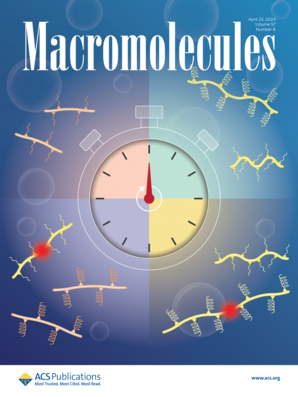Controlling the Morphology of Conjugated Polyfluorene through Physical Stretching and Solvent Variation
IF 5.1
1区 化学
Q1 POLYMER SCIENCE
引用次数: 0
Abstract
In this paper, the intentional control of morphology and photophysical properties of a conjugated polydiarylfluorene, PODPF, in thin films is achieved through various systematic approaches including physical stretching when hosted in a highly elastic polymer, poly(vinyl butyral) (PVB) at various weight-to-weight ratios, and by varying the solvent. Microspectroscopic techniques were employed to monitor the resulting variations. Significant differences in the excitation and emission spectra are observed as functions of the concentration of PODPF mixed in the PVB film. This indicates the formation of different types of aggregates in these films through the coupling between dipoles with different relative orientations. Fluorescence anisotropy images show dramatic differences as a function of the extent of physical stretching of the film and as a function of PODPF concentration. Shifts in the emission spectra of the films as a function of the concentration in films cast from different solvents illustrate that the morphology of the films is highly dependent on the properties of the solvent from which the film is cast. The results highlight effective approaches for influencing the morphology and properties of conjugated polymers in thin films, with particular emphasis on the crucial role of solvent selection. Theoretical modeling is also employed to provide insight into the underlying principles governing these observed phenomena.

通过物理拉伸和溶剂变化控制共轭聚芴的形态
在本文中,通过各种系统方法,包括在高弹性聚合物聚乙烯醇(乙烯基丁醛)(PVB)中以不同的重量比进行物理拉伸,以及通过改变溶剂,实现了薄膜中共轭聚二芳基芴(PODPF)的形态和光物理性质的有意控制。显微光谱技术被用来监测由此产生的变化。在PVB薄膜中,随着PODPF浓度的变化,激发光谱和发射光谱存在显著差异。这表明在这些薄膜中通过不同相对取向的偶极子之间的耦合形成了不同类型的聚集体。荧光各向异性图像显示出薄膜物理拉伸程度和PODPF浓度的显著差异。薄膜的发射光谱随不同溶剂中薄膜浓度的变化表明,薄膜的形态高度依赖于制造薄膜的溶剂的性质。结果强调了影响薄膜中共轭聚合物形态和性能的有效方法,特别强调了溶剂选择的关键作用。理论建模也被用来提供对控制这些观察到的现象的基本原理的见解。
本文章由计算机程序翻译,如有差异,请以英文原文为准。
求助全文
约1分钟内获得全文
求助全文
来源期刊

Macromolecules
工程技术-高分子科学
CiteScore
9.30
自引率
16.40%
发文量
942
审稿时长
2 months
期刊介绍:
Macromolecules publishes original, fundamental, and impactful research on all aspects of polymer science. Topics of interest include synthesis (e.g., controlled polymerizations, polymerization catalysis, post polymerization modification, new monomer structures and polymer architectures, and polymerization mechanisms/kinetics analysis); phase behavior, thermodynamics, dynamic, and ordering/disordering phenomena (e.g., self-assembly, gelation, crystallization, solution/melt/solid-state characteristics); structure and properties (e.g., mechanical and rheological properties, surface/interfacial characteristics, electronic and transport properties); new state of the art characterization (e.g., spectroscopy, scattering, microscopy, rheology), simulation (e.g., Monte Carlo, molecular dynamics, multi-scale/coarse-grained modeling), and theoretical methods. Renewable/sustainable polymers, polymer networks, responsive polymers, electro-, magneto- and opto-active macromolecules, inorganic polymers, charge-transporting polymers (ion-containing, semiconducting, and conducting), nanostructured polymers, and polymer composites are also of interest. Typical papers published in Macromolecules showcase important and innovative concepts, experimental methods/observations, and theoretical/computational approaches that demonstrate a fundamental advance in the understanding of polymers.
 求助内容:
求助内容: 应助结果提醒方式:
应助结果提醒方式:


